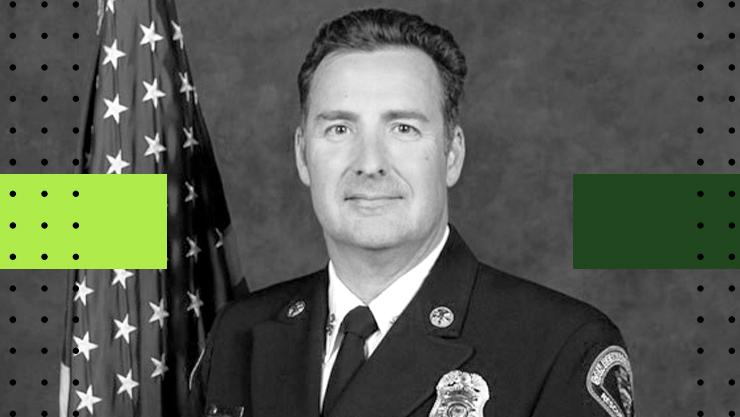
Adopting digital tools to support policing
with Ian BellOn this episode, host Olivia Neal speaks to Ian Bell, CEO of the UK’s Police Digital Service. He offers an inside look into the role of the Police Digital Service and how it is enabling UK policing to better protect the communities it serves.
Episode summary
On this episode, host Olivia Neal speaks to Ian Bell, CEO of the UK’s Police Digital Service. He offers an inside look into the role of the Police Digital Service and how it is harnessing the power of digital, data and technology to enable UK policing to better protect the communities it serves.
Listen to this episode on any of these podcast platforms:
What opportunities does the adoption of digital technology offer for policing?
On this episode, host Olivia Neal speaks to Ian Bell, CEO of the UK’s Police Digital Service. He offers an inside look into the role of the Police Digital Service and how it is harnessing the power of digital, data and technology to enable UK policing to better protect the communities it serves.
Defining the role of the Police Digital Service
Ian Bell is the CEO of the Police Digital Service in the United Kingdom.
“PDS, as we call it is still a relatively new and maturing organization across the law enforcement landscape in the UK. And the PDS was born only April 1, 2021. So we’ve been working really hard to think about the nature of our mission, our purpose, and really the intrinsic links of how we perform a critical role in the delivery of the National Digital Policing Strategy.”
Bell continued, “The ultimate ambition of the organization, is to really think about harnessing all things security, digital, data, technology, and how we really encompass bringing all of those together to think about how we enable UK policing to better protect the communities that it serves. We’re interesting blend from a governance perspective. So, we’re pretty much a hybrid organization. And if I unpack that a little, it means that, we’re a private company limited by guarantee from a perspective of how we’re governed, but we are absolutely solely funded by public money. And so, the intrinsic nature of what we do and how we do it is that we are owned by policing through the Police and Crime Commissioners of England and Wales, as well as other members of other law enforcement agencies. And we’re absolutely here to serve policing on that basis.”
Bell described PDS’s mantra as an organization that’s absolutely for policing, by policing, and with policing.
“We’re here to think about the enhancing of digital services from end-to-end as a collective across the policing landscape, and looking at that environment from end-to-end. Our role here is to absolutely be a cooperative body that really begins to enhance the capabilities that we really need to improve on, that everybody in our world and across our landscape has signed up to, when we talk about the delivery of the digital policing strategy.”
How digital technology and policing has changed in recent years
“My policing career now goes all the way back to 2008 when I worked in a single force, and then worked as a CIO for three forces. I then had the responsibility of setting up probably the biggest digital transformation program that we’ve seen, when we talk about adoption of modern tools and technologies. That was the national enabling program wholly built around M365 as a full product suite, the world that we needed to move into from a national identity platform, and then clearly the work that we’ve done to build our National Management Center, which is ultimately, our security platform for which we manage all of our cloud endpoints.”
Bell explained, “I guess the one thing that has been relentless is continual pace of change, and the whole adoption of really wanting to move and see policing move collectively forward in the adoption of modern tools on a basis of where we want it to be. But we’re surrounded by a wealth of digital debt, probably beyond the likes of legacy and into heritage. When we think about some of the products that are still surrounded by us, we have the example of the Police National Computer, which is probably verging on 47-48 years old now. So, that probably goes to the dark depths of time versus the reality of the basis of now, really thinking about cloud and the basis of off-the-shelf product, moving away from the static days of application development and siloed development that saw us probably create additional complexity in our environments, rather than thinking about the rationalization capability that we’ve got now.”
Bell mentioned that COVID was probably the most significant change he’s seen in recent years, and for good reason.
“COVID became the game changer that really began to accelerate, for me, the increase in adoption of tools that reenabled and reenvisaged the capabilities of our workforce to probably the quickest response that I’ve ever witnessed, in any sector on that basis. All of a sudden, when you think about the basis of what we do and the way that we respond to public service, public safety and justice, to the broader extent, we have our workforce and our operational workforce who are clearly well practiced on the front line. But then, we have a debt for services that sit behind the scenes, and really beginning to think about the flexibility that we needed to give people the opportunity to work in any location, practically.”
Bell continued, “To be able to relocate quickly off the back of a response to, the very early days of the pandemic, being able to have an ability to respond through these great tools, and being able to work with all the forces, having built the blueprints, having built the designs, having done the assurance that allowed us to work nationally to think about the pace of rollout to get initial stages, Outlook from a 365 perspective and Teams adopted quickly to give us the communication channels, to give us the people the opportunity still to collaborate, and probably recreate some of that office experience that they had was paramount. We needed to make sure it was a collective national response in the way that we were going to deploy these tools so that nobody missed out.”
“That was the tipping point that said there is a real opportunity here. The digital strategy is something that becomes real. It’s not shelfware, it’s not a document that we can pick up once in a while. This is something that we’re going to live and breathe on that basis. And I genuinely think that we’ll look back over the course of the next 5, 10 years, and absolutely COVID, for whatever an inhibitor it was, it was absolutely an enabler for dramatic change in adoption of new digital product moving forwards.”
Citizen expectations are changing too
“I think most of the public really have an expectation now around digital, when I think about how we purpose and package up digital by default. For me, it’s around two key ambitions that we have in the strategy around what does it mean to really offer seamless as an experience; and to accompany that, then, what are we doing to match that on a relative basis inside our organizations. And that’s, for me, really around how we enable our offices and staff through digital.”
Bell stressed the importance of making sure that PDS can offer real-time information, great quality interactions, really strong data visualization, and other purposeful ways for people to connect with forces.
“Over the next three or four years, we’ll really begin to enhance, once again, what that public contact interface really begins to mean for us. We need to think about the broader channels, again, from a contact center perspective. How do we introduce video? How do we think about the adoption through social media channels? How do we really begin to think about the interfaces of today?”
Bell continued, “The everchanging complexity of the social demographic is continuing to make us think very differently. We have no social exclusion policy, so we’ve got to remember that the basis of the ways and means that people have always contacted us has to remain open. Our job, as I’ve already described, when we look at enabling services end-to-end, then reducing harm, creating confidence, and making sure that in any way, in any service that we provide, has the legitimacy that allows us to continue to play our part in increasing public confidence on that basis. So, it’s a challenge that’s relished.”
Has technology improved outcomes for PDS?
“I’ll be slightly contentious and say it’s probably rarely technology on its own that transforms anything. When we talk about transformation, the one thing that we always tried to do is we plan together what we want to achieve, from a business perspective, what it means from a security piece, what does it mean from a tech piece? What does it mean from a data perspective?”
Bell continued, “We’ve worked really hard through our business engagement structure to really think about the power of Power Apps and the Power Platform, and to really think about some of those niche business challenges that we can solve, how we think about user experience, how we think about the pertinence and ease of deployment and accessibility of some of these applications. And one of the things that we’ve got within the PDS cabinet is catalog. We call it the Solutions Catalog. It’s managed in our tenant. It’s where we share a framework of solutions. And what we do then is we become a vehicle of really creating the awareness around these well-evidenced, these well-practiced and to some extent, best practice applications that have come along, that genuinely solve business problems that have been debated developed by folk at the heart of the matter.”
“When we talk about transformation, we talk about changing hearts and minds, we talk about digital being the enabler, some of the stuff that comes through the door and enters into the solution catalog that then becomes reused, time and time and time again by other forces, just picking it up and then adopting it, as is. There are a huge number of shared challenges where we can just bring colleagues together and do this in a pretty common and consistent fashion. And that’s what excites me, about the tool sets that we’re now adopting, that gives us the agility to be able to do some of that.”
Most of this can be replicated
“Whether it’s about PDS or whether it’s about what we achieved as the collective, when we started on the modernization journey and when we think about the adoption of 365, and what we did around the ambition that we had, really, to bring our leaders, our users to understand what a vast set of strategic shared ambitions would really look like, focusing on the benefits of really well-coordinated change, but collective buy-in to what we were going to do to adopt these products, moving forwards.”
Bell explained, “We spent a lot of time developing blueprints collectively, as a community. We went through an assurance process. We went through technical requirements. We worked through the balance of, you know, what are the differences locally versus that of the national agencies? How could we really think about the benefit of shared standards and being able to put these into common packages that people could just lift up and adopt? That set the baseline, not only then for adoption of product for the future, but it also set the baseline, for me, then, around the basis of this organization, around the role and purpose it can have, around the delivery of digital for the future, certainly from a UK policing perspective.”
To find out more:
- Learn more about how Microsoft can support digital transformation in Public Safety and Justice
- Learn more about the UK Police Digital Service on their website
About the Center of Expertise
Microsoft’s Public Sector Center of Expertise brings together thought leadership and research relating to digital transformation in the public sector. The Center of Expertise highlights the efforts and success stories of public servants around the globe, while fostering a community of decision makers with a variety of resources from podcasts and webinars to white papers and new research. Join us as we discover and share the learnings and achievements of public sector communities.
Questions or suggestions?











